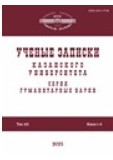ПОВСЕДНЕВНАЯ ЖИЗНЬ СТУДЕНТОВ КАЗАНСКОЙ ДУХОВНОЙ АКАДЕМИИ В ГОДЫ ПЕРВОЙ МИРОВОЙ ВОЙНЫ
EVERYDAY LIFE OF STUDENTS OF THE KAZAN THEOLOGICAL ACADEMY DURING THE FIRST WORLD WAR
Author(s): Guzel Vazykhovna Ibneyeva, P.A. MayorovSubject(s): Christian Theology and Religion, Local History / Microhistory, Higher Education , History of Education, Pre-WW I & WW I (1900 -1919)
Published by: Казанский (Приволжский) федеральный университет
Keywords: First World War; Kazan Theological Academy; daily life; students;
Summary/Abstract: This article summarizes the results of a study on the daily life of students at the Kazan Imperial Theological Academy in 1914–1917 when the life of civilians was severely affected by the First World War. Through the analysis of archival materials and literary sources, a close look is taken at such major constituents of everyday activities as space and time, material means, as well as clothing and dietary habits. During that period, most students resided in boarding houses, which also determined their living conditions: state-paid students received food, sleeping and working space, clothes, treatment, etc. The life of all students of the Academy revolved around the main building on the Arsk Field of Kazan. They spent most of their time there but were occasionally allowed to make short-term trips into the city. When the First World War broke out, the students started visiting more places. They went to the infirmaries and hospitals to take part in religious sermons and entertainment events. Many of them fell into a poor financial situation because the annual basic scholarship was only enough to pay for staying at the boarding house. The canteen no longer served sufficient meals, especially during the fast, so the students were malnourished and forced to seek out other sources of food. They were offered nutritious food only on holidays. The statutory clothes (raincoats, uniforms, jackets, trousers, and shoes) supplied by the Academy were of little use to keep warm in the cold seasons. In 1917, the biggest changes occurred. The premises of the Academy were gradually militarized. By the end of the year, due to the social upheavals and the economic crisis, only 142 out of 300 students continued their education. They were mainly accommodated in government apartments, and the classes were held either in the assembly hall or in the rector’s apartment.
Journal: Ученые записки Казанского университета. Серия Гуманитарные науки
- Issue Year: 165/2023
- Issue No: 1-2
- Page Range: 155-167
- Page Count: 13
- Language: Russian

